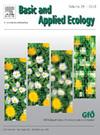灌木抗草食动物防御对草食动物密度的增加表现出非线性和变化的响应
IF 3.5
2区 环境科学与生态学
Q2 ECOLOGY
引用次数: 0
摘要
植物可能产生诱导防御,如长刺或次生化合物,以应对更高水平的草食。然而,目前尚不清楚植物的物理和化学防御是否会随着食草动物密度的梯度而逐渐增加。我们假设所选灌木的物理和化学防御能力随着草食动物密度的增加而增强。我们在美国德克萨斯州南部的两个牧场上分别设置了四个0.81平方公里的围场,以防止白尾鹿(Odocoileus virginianus)进出。各牧场鹿的目标密度分别为0(对照)、25、49和74头/km2。在每个围场中随意提供颗粒饲料。2014年7月,我们在每个牧场的四个研究牧场中,分别选择了10株黑刺金合欢(Vachellia rigidula)、扭刺金合欢(Vachellia schaffneri)和刺杨树(Celtis ehrenbergiana)。2014-2016年7月,我们在每棵植株上标记茎,记录主茎、侧茎和刺的长度。我们分别于2014年7月和2015年10月采集了3种浏览物种各20株的叶片和茎样,分析了粗蛋白质和单宁。与对照相比,鹿群密度处理的刺槐枝密度增加38% ~ 123%(25只鹿/km2),刺密度增加27%(74只鹿/km2)。49只/km2处理的刺莓枝密度是对照处理的2.5倍。鹿密度增加对植物抗草食动物防御的诱导作用主要发生在黑刺金合欢上。一个关键的发现是,灌木诱导的物理和化学防御可以以非线性的方式响应草食动物密度的增加,并且防御策略的组合可以根据草食动物密度而变化。本文章由计算机程序翻译,如有差异,请以英文原文为准。
Shrub anti-herbivore defenses exhibit non-linear and varied responses to increased herbivore density
Plants may produce induced defenses such as longer thorns or secondary compounds to cope with higher levels of herbivory. However, it is unclear if physical and chemical plant defenses increase incrementally along a gradient of herbivore densities. We hypothesized that physical and chemical anti-herbivore defenses in selected shrubs increase with increasing herbivore density. We tested our hypothesis using four 0.81 km2 paddocks on each of two ranches in southern Texas, USA, that were fenced to exclude ingress and egress by white-tailed deer (Odocoileus virginianus). Target densities of deer on each ranch were 0 (control), 25, 49, and 74 deer/km2. Pelleted feed was provided ad libitum in each paddock. In July 2014, we selected ten plants of blackbrush acacia (Vachellia rigidula), twisted acacia (Vachellia schaffneri), and spiny hackberry (Celtis ehrenbergiana) in each of the four research paddocks on each ranch. We marked stems on each plant and recorded length of the main stem, lateral stems, and thorns during July 2014–2016. We collected leaf and stem samples from 20 plants of each of the three browse species during July and October 2014 and 2015 for analysis of crude protein and tannins. Branch density of blackbrush acacia was 38 % (25 deer/km2) to 123 % (49 deer/km2) greater in deer density treatments and thorn density of blackbrush acacia was 27 % greater in treatments with 74 deer/km2 than in control treatments. Spiny hackberry branch density was 2.5 times greater in treatments with 49 deer/km2 than in control treatments. Induction of plant antiherbivore defenses with increasing deer density occurred primarily in blackbrush acacia. A key finding is that induced physical and chemical defenses in shrubs can respond to increasing herbivore density in a non-linear fashion and the combination of defense strategies can vary depending on herbivore density.
求助全文
通过发布文献求助,成功后即可免费获取论文全文。
去求助
来源期刊

Basic and Applied Ecology
环境科学-生态学
CiteScore
6.90
自引率
5.30%
发文量
103
审稿时长
10.6 weeks
期刊介绍:
Basic and Applied Ecology provides a forum in which significant advances and ideas can be rapidly communicated to a wide audience. Basic and Applied Ecology publishes original contributions, perspectives and reviews from all areas of basic and applied ecology. Ecologists from all countries are invited to publish ecological research of international interest in its pages. There is no bias with regard to taxon or geographical area.
 求助内容:
求助内容: 应助结果提醒方式:
应助结果提醒方式:


